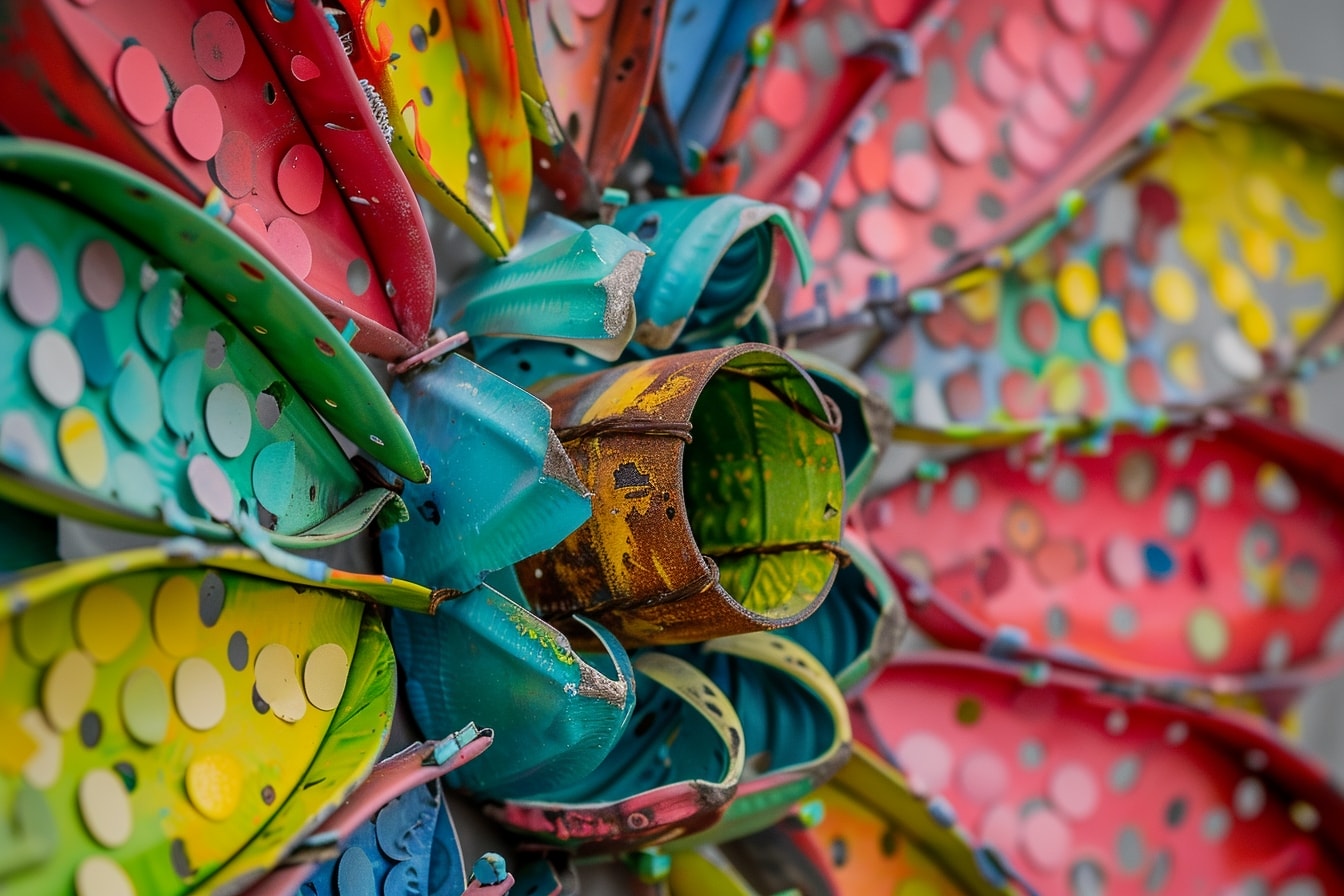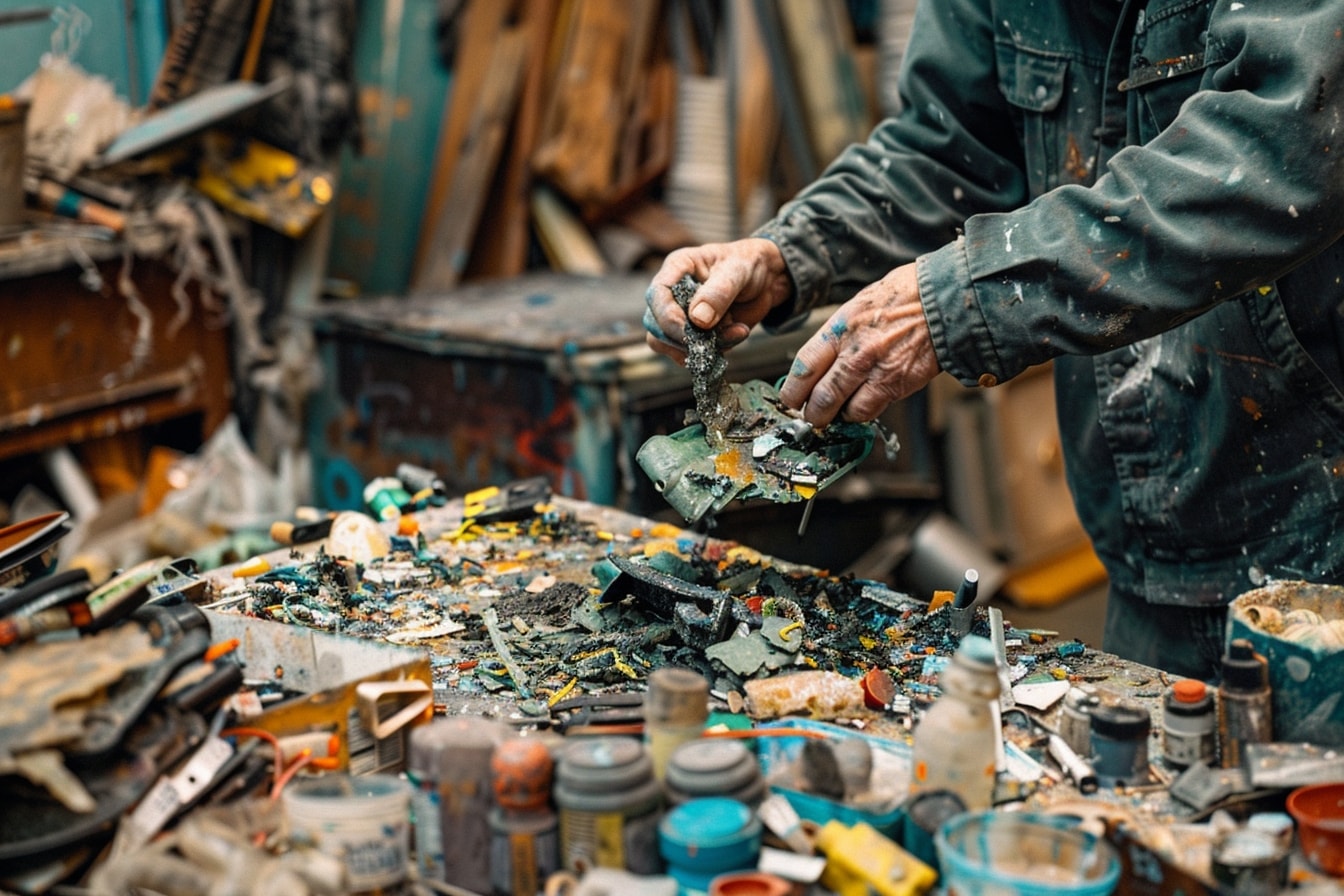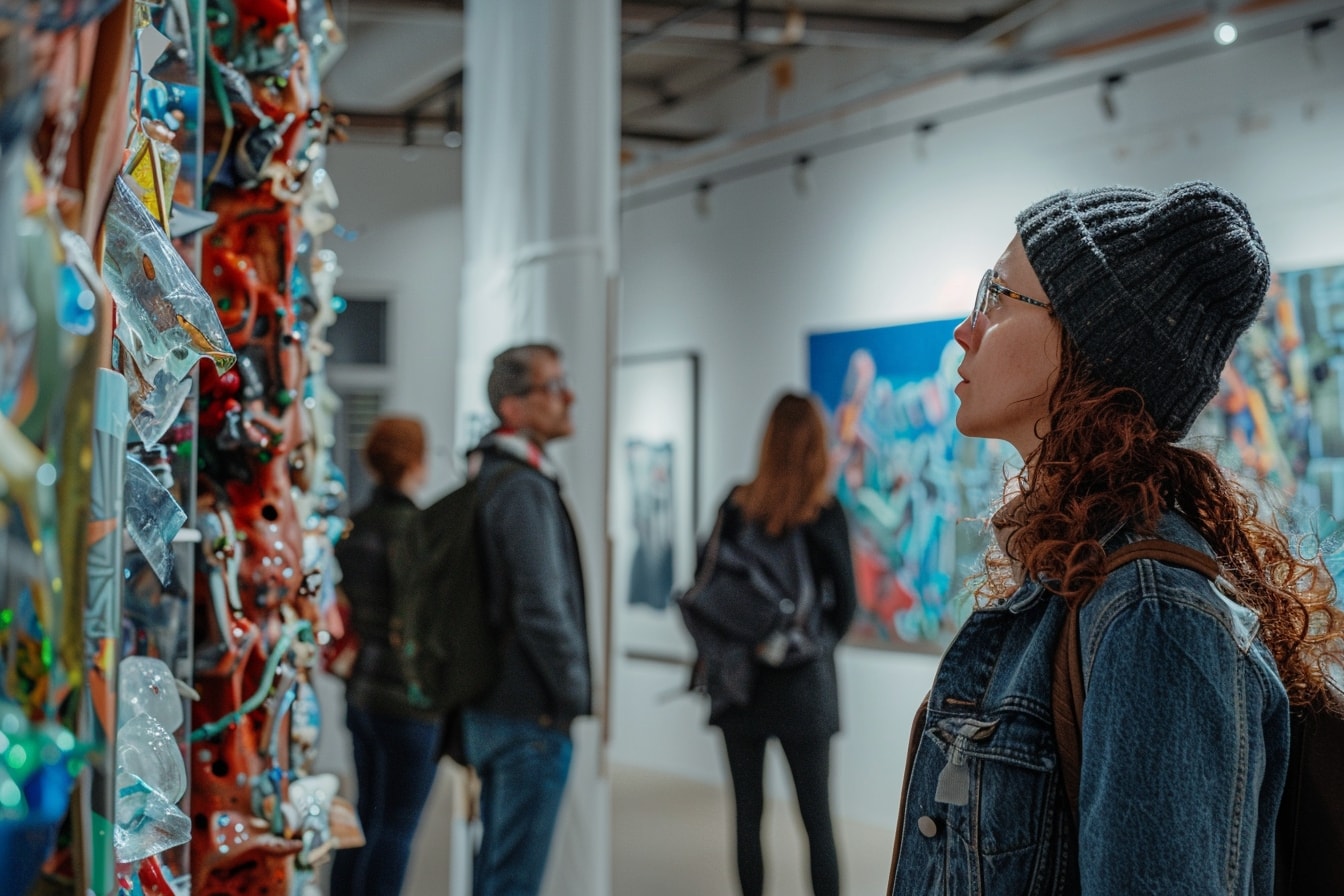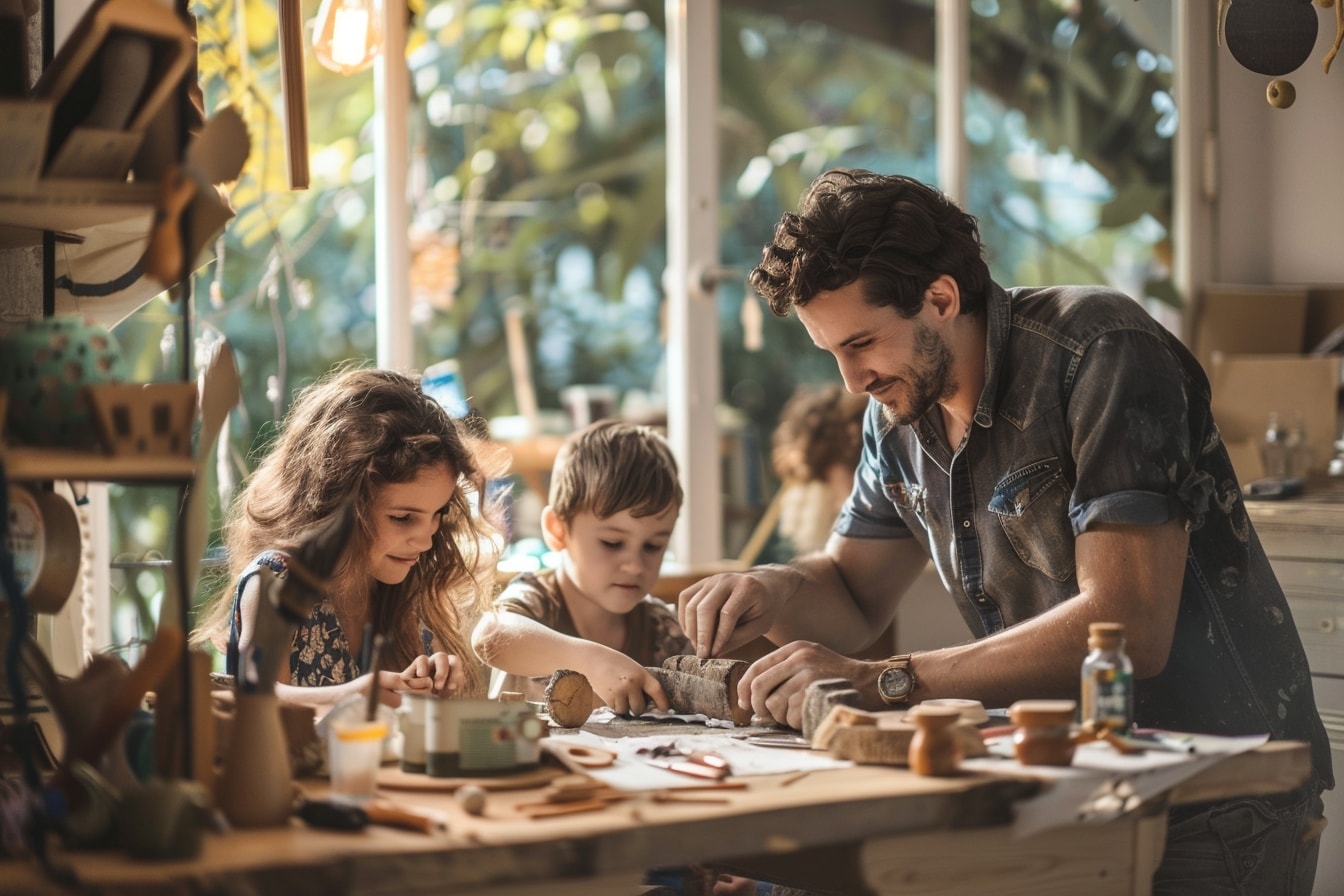Table of Contents
ToggleRecycled Art Sculptures: Eco-Friendly Creativity
Picture this: You’re strolling through a bustling art fair, surrounded by vibrant colors and captivating sculptures. But as you pause to admire a particularly striking piece, something catches your eye – it’s not just the beauty of the artwork that’s captivating, but the materials it’s made from. Plastic bottles, metal scraps, discarded paper – ordinary objects transformed into extraordinary works of art through the power of creativity and innovation.
Recycled art sculptures, once a niche curiosity, are now taking center stage in the art world, captivating audiences with their ingenuity and environmental consciousness. As we witness the alarming effects of climate change and environmental degradation, the need for sustainable practices has never been more urgent. And in the realm of art, where beauty and expression collide, recycled materials are becoming the medium of choice for artists seeking to make a statement – not just aesthetically, but ethically.
But why recycled art, you might wonder? Beyond the obvious appeal of repurposing materials and reducing waste, there’s a deeper significance to this burgeoning movement. It’s about challenging conventional notions of beauty and value, about finding inspiration in unexpected places, and about embracing imperfection as a testament to resilience and resourcefulness.
Consider, for instance, the vibrant culture of the Caribbean, where creativity knows no bounds and necessity breeds innovation. From makeshift instruments crafted from discarded cans to colorful mosaics fashioned from broken tiles, the spirit of upcycling is deeply ingrained in Caribbean communities, reflecting a profound respect for the environment and a reverence for the beauty found in the seemingly mundane.
And so, as we embark on this journey into the world of recycled art sculptures, let us not only marvel at the ingenuity of the artists but also reflect on our own relationship with the planet. For in the hands of a skilled artist, even the humblest of materials can be transformed into something extraordinary – a testament to the power of creativity, the resilience of nature, and the boundless potential for positive change.

Unleashing Creative Potential
When it comes to recycled art sculptures, the only limit is your imagination. In this section, we’ll delve into the boundless creative potential of working with recycled materials, exploring the transformative power of art and the myriad ways in which ordinary objects can be repurposed into extraordinary works of beauty and meaning.
At the heart of recycled art lies the spirit of innovation – the willingness to look beyond conventional materials and techniques and to see the potential for beauty in the discarded and overlooked. Whether it’s transforming old bicycle parts into whimsical sculptures or fashioning intricate tapestries from discarded fabric scraps, artists around the world are pushing the boundaries of creativity and redefining what it means to create art.
One of the most fascinating aspects of working with recycled materials is the element of surprise. Unlike traditional art supplies, which come with preconceived notions of form and function, recycled materials invite experimentation and improvisation. A rusted piece of metal becomes a striking focal point in a sculpture; a tattered book finds new life as a canvas for expression. The possibilities are as endless as the imagination, and the results are often breathtaking in their originality.
- Explore Different Techniques: From assemblage and collage to sculpture and installation, there are countless techniques to explore when working with recycled materials. Experiment with layering, cutting, and shaping to discover unique textures and forms.
- Find Inspiration in Unexpected Places: Look beyond traditional art supplies for inspiration. Wander through thrift stores, flea markets, and salvage yards in search of materials that speak to you. You never know what hidden treasures you might unearth.
- Embrace Imperfection: One of the joys of working with recycled materials is the inherent imperfections they bring. Embrace the quirks and idiosyncrasies of your materials, allowing them to guide your creative process and infuse your work with character and charm.
- Push the Boundaries: Don’t be afraid to think outside the box and push the boundaries of what’s possible with recycled art. Incorporate unexpected elements, mix and match materials, and experiment with scale and proportion to create truly one-of-a-kind pieces.
Ultimately, the key to unleashing your creative potential lies in embracing the inherent beauty and versatility of recycled materials. By seeing the world through the lens of possibility rather than limitation, you’ll discover a whole new universe of artistic expression waiting to be explored.

Overcoming Challenges
Embarking on a journey into the world of recycled art sculptures can be an exhilarating adventure, but it’s not without its challenges. In this section, we’ll explore some of the common hurdles artists face when working with recycled materials and offer practical solutions and strategies for overcoming them.
One of the primary challenges artists encounter when creating recycled art sculptures is sourcing materials. Unlike traditional art supplies, which can be easily purchased from art supply stores, recycled materials often require more creative sourcing methods. Thrift stores, salvage yards, and even roadside dumpsters can yield hidden treasures, but finding the right materials in the right quantities can be a daunting task.
- Get Creative with Sourcing: Think outside the box when it comes to finding materials for your recycled art projects. Consider reaching out to local businesses, schools, and community organizations for donations or partnerships. You’d be surprised at how willing people are to part with their unwanted materials if they know they’ll be used for a creative purpose.
- Build a Network: Cultivate relationships with other artists, makers, and recyclers in your community. Attend workshops, art fairs, and networking events to connect with like-minded individuals and exchange ideas and resources. Building a supportive network can not only help you find materials but also provide valuable advice and encouragement along the way.
- Think Long-Term: Consider the longevity and durability of your materials when sourcing for your recycled art projects. While it can be tempting to use whatever materials are readily available, opting for high-quality, durable materials can ensure that your artwork stands the test of time.
Another common challenge artists face when working with recycled materials is maintaining structural integrity. Unlike traditional art supplies, recycled materials may not always have the same strength or stability, posing challenges when it comes to building and assembling sculptures.
- Reinforce Weak Points: Identify potential weak points in your sculpture and reinforce them with additional materials or structural supports. Consider experimenting with different adhesives, fasteners, and reinforcement techniques to ensure that your sculpture remains stable and secure.
- Experiment and Iterate: Don’t be afraid to experiment and iterate on your designs until you find the right balance of form and function. Start with small-scale prototypes to test different materials and construction methods, and refine your design based on what works best.
- Learn from Failure: Embrace failure as an essential part of the creative process. If a particular material or technique doesn’t work out as planned, don’t be discouraged – use it as an opportunity to learn and grow. Sometimes the most unexpected setbacks can lead to the most innovative solutions.
By approaching these challenges with creativity, resourcefulness, and perseverance, artists can unlock the full potential of recycled materials and create truly remarkable works of art that inspire and captivate audiences around the world.

Trends and Innovations
As the world of art continues to evolve, so too do the trends and innovations in recycled art sculptures. In this section, we’ll take a closer look at some of the latest developments shaping the landscape of recycled art, from cutting-edge technologies to groundbreaking techniques that are pushing the boundaries of creativity and sustainability.
One of the most exciting trends in recycled art is the integration of technology into the creative process. From 3D printing with recycled materials to digital fabrication techniques, technology is opening up new possibilities for artists to experiment and innovate in their work.
- 3D Printing with Recycled Materials: Advances in 3D printing technology have made it possible to create intricate sculptures using recycled plastics and other materials. Artists are harnessing the power of 3D printing to produce complex, multi-dimensional works that would be difficult or impossible to achieve using traditional methods.
- Digital Fabrication: Digital fabrication techniques, such as laser cutting and CNC machining, are revolutionizing the way artists work with recycled materials. These technologies allow for precise, automated fabrication of sculptures and other artworks, opening up new avenues for creativity and experimentation.
- Augmented Reality: Some artists are exploring the use of augmented reality (AR) to enhance their recycled art sculptures. By overlaying digital elements onto physical artworks, artists can create immersive, interactive experiences that engage viewers in new and exciting ways.
Alongside technological advancements, there’s a growing emphasis on sustainability and environmental stewardship in the world of recycled art. Artists are increasingly incorporating eco-friendly materials and techniques into their work, prioritizing conservation and resourcefulness in their creative process.
- Upcycling: Upcycling – the practice of repurposing discarded materials into new products of higher value – is becoming increasingly popular in the world of recycled art. Artists are finding innovative ways to breathe new life into old materials, transforming trash into treasure in the process.
- Biodegradable Materials: With concerns about plastic pollution on the rise, many artists are turning to biodegradable materials as a more sustainable alternative. Materials such as bamboo, hemp, and recycled paper offer artists a way to create beautiful, durable artworks without contributing to environmental harm.
- Community Collaboration: Collaboration and community engagement are also driving trends in recycled art. Artists are partnering with local communities, schools, and organizations to create large-scale public art installations made from recycled materials, fostering a sense of environmental awareness and community pride.
As the world becomes increasingly aware of the urgent need for sustainability and conservation, recycled art sculptures are poised to play a pivotal role in inspiring change and promoting environmental stewardship. By embracing new technologies, techniques, and materials, artists are redefining what it means to create art that not only captivates the imagination but also makes a positive impact on the world around us.

Bringing Sustainability Home
While the world of recycled art sculptures may seem like a realm reserved for professional artists and seasoned creatives, the truth is that anyone can embrace sustainability and creativity in their own homes. In this section, we’ll explore practical steps for incorporating recycled art into everyday life, from simple DIY projects to larger community initiatives that promote environmental awareness and stewardship.
One of the easiest ways to bring sustainability home is by getting creative with everyday materials that might otherwise end up in the trash. Take a cue from the world of recycled art and look for opportunities to repurpose items in your home in imaginative and unexpected ways.
- DIY Projects: Start small by tackling DIY projects that use recycled materials you already have on hand. Turn old glass jars into stylish vases, transform cardboard boxes into decorative storage containers, or repurpose worn-out clothing into colorful patchwork quilts. The possibilities are endless, and the satisfaction of creating something beautiful from materials that might otherwise have been discarded is immeasurable.
- Art Education: Introducing recycled art into the classroom is another powerful way to bring sustainability home. Teachers can incorporate lessons on recycling, upcycling, and eco-friendly art techniques into their curriculum, empowering students to explore their creativity while learning about the importance of environmental stewardship. By instilling a sense of responsibility and respect for the planet at a young age, we can help shape the next generation of eco-conscious citizens.
- Community Engagement: Community art projects offer another avenue for bringing sustainability home. From neighborhood clean-up efforts to collaborative public art installations, there are countless ways for communities to come together to celebrate creativity and promote environmental awareness. By working together to beautify public spaces with recycled art, we not only create lasting works of beauty but also foster a sense of connection and pride in our shared environment.
But perhaps the most important step in bringing sustainability home is simply to embrace a mindset of mindfulness and intentionality in our everyday choices. Whether it’s opting for reusable instead of disposable products, supporting local artists who prioritize sustainability in their work, or advocating for policies that promote recycling and conservation, each of us has the power to make a difference in our own lives and communities.
By incorporating recycled art into our homes, our classrooms, and our communities, we not only express our creativity and individuality but also make a tangible contribution to the health and vitality of the planet we call home.

Empowering Change
Recycled art sculptures have the power to do more than just adorn our homes and galleries – they can inspire change, ignite activism, and foster a deeper connection to the world around us. In this section, we’ll explore how recycled art can be a catalyst for positive change, empowering individuals and communities to make a difference in their own lives and the world at large.
At its core, recycled art is a form of storytelling – a way for artists to communicate their vision, values, and concerns to a broader audience. By using recycled materials, artists not only create visually striking artworks but also send a powerful message about the importance of conservation, resourcefulness, and environmental stewardship.
- Raising Awareness: One of the most significant ways recycled art can empower change is by raising awareness about environmental issues. Through their work, artists shine a spotlight on the impact of consumerism, waste, and pollution on our planet, sparking conversations and inspiring action among viewers.
- Driving Advocacy: Recycled art can also be a powerful tool for advocacy, providing a platform for artists to address pressing social and environmental concerns. Whether it’s advocating for sustainable practices in the fashion industry, raising awareness about plastic pollution in our oceans, or promoting renewable energy solutions, recycled art has the power to amplify voices and drive meaningful change.
- Fostering Connection: Perhaps most importantly, recycled art has the ability to foster connection and community among individuals who share a common commitment to sustainability and creativity. Through workshops, exhibitions, and collaborative projects, artists and activists can come together to share ideas, resources, and inspiration, forming a supportive network that empowers each member to make a difference in their own unique way.
But the impact of recycled art extends far beyond the walls of galleries and studios – it has the power to transform hearts and minds, sparking a shift in consciousness that reverberates throughout society. By challenging us to see the world through a different lens, recycled art invites us to reconsider our relationship with the planet and each other, empowering us to take meaningful action to create a more sustainable and equitable future for all.
So let us embrace the transformative power of recycled art, not just as a form of creative expression, but as a force for positive change in our world. Together, we can harness the power of art to inspire, educate, and empower, creating a brighter, more sustainable future for generations to come.
As we come to the end of our journey into the world of recycled art sculptures, it’s clear that this vibrant and dynamic field holds immense potential to inspire, educate, and empower. From the breathtaking beauty of intricately crafted sculptures to the profound message of sustainability and stewardship they convey, recycled art has captured the hearts and imaginations of artists and audiences around the world.
Throughout this exploration, we’ve seen how recycled art is more than just a creative endeavor – it’s a powerful tool for positive change. By repurposing discarded materials into works of beauty and meaning, artists are not only reducing waste and conserving resources but also challenging us to rethink our relationship with the planet and each other.
But the impact of recycled art extends far beyond the art world – it has the power to transform lives and communities, sparking conversations, driving advocacy, and fostering connection among individuals who share a common commitment to sustainability and creativity.
- Recap: As we reflect on the key insights and takeaways from our exploration of recycled art sculptures, let us remember the beauty and significance of turning trash into treasure, of finding inspiration in unexpected places, and of embracing imperfection as a testament to resilience and resourcefulness.
- Call to Action: Inspired by the creativity and ingenuity of artists working with recycled materials, let us each find ways to incorporate sustainability and eco-friendly practices into our own lives. Whether it’s through supporting local artists, participating in community clean-up efforts, or advocating for policies that promote recycling and conservation, each of us has the power to make a difference.
- Closing Thought: As we bid farewell to this exploration of recycled art sculptures, let us carry with us the lessons learned and the inspiration gained. Let us continue to seek out beauty in unexpected places, to challenge conventional notions of value and worth, and to work together to create a brighter, more sustainable future for all.
So let us go forth with renewed purpose and determination, knowing that through the transformative power of recycled art, we can make a meaningful and lasting impact on the world around us.
Want to take your knowledge to the next level? Check out these must-read articles:
Organize your baby’s wardrobe with our baby clothes closet organizer products! Our organizers are designed specifically for baby clothes. Get your baby’s clothes neat and tidy with our selection of organizers – shop now!
Step into Sue Brown's World of Baby Care, where you'll find a treasure trove of knowledge and wisdom waiting to be explored. Sue's dedication to providing accurate and up-to-date information on baby care shines through in every article, blog post, and resource she shares. From newborn essentials to sleep training tips, breastfeeding advice to nurturing your baby's development, Sue covers a wide range of topics that are essential for every parent to know. Her warm and compassionate approach creates a sense of community and reassurance, making her website a safe haven for parents seeking guidance and support. Let Sue Brown be your partner in this beautiful journey of parenthood, as she empowers you to create a loving, nurturing, and thriving environment for your little one.
- 2025’s Most Innovative Baby Products Worth the Investment - October 16, 2025
- Singing to Your Baby: The Neuroscience of Musical Connection - October 13, 2025
- Temperature-Appropriate Baby Dressing Guide - October 12, 2025



